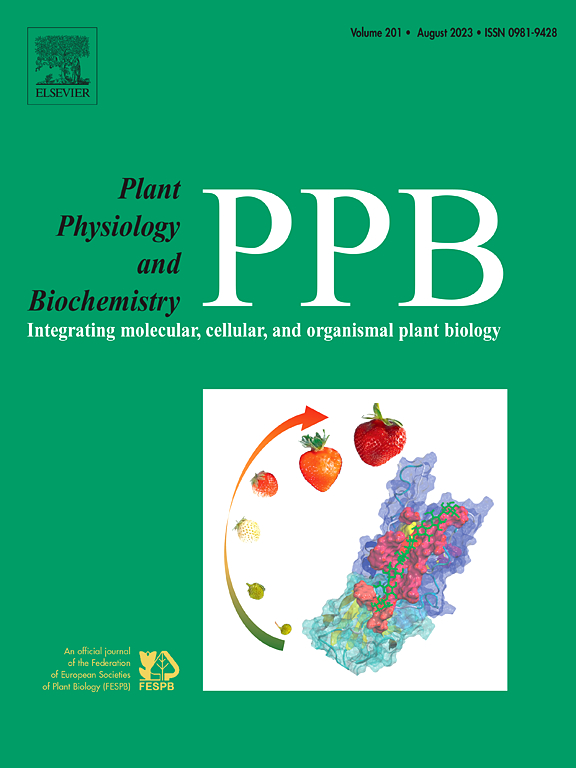Effect of exogenous IBA on root morphology and endogenous hormone Metabolic pathways in castor seedlings under Pb/Zn stress
IF 6.1
2区 生物学
Q1 PLANT SCIENCES
引用次数: 0
Abstract
Ricinus communis, a plant of significant industrial value for its oil, is renowned for its robust root system and vigorous growth, qualities that render it an exemplary candidate for the ecological remediation of soils contaminated with heavy metals. The impact of heavy metal stress on root development is characterized by inhibition, a phenomenon whose underlying mechanisms are not fully elucidated. To shed light on this, a study was conducted wherein varying concentrations of the exogenous auxin, IBA, were applied to the roots of Ricinus communis to scrutinize its influence on the endogenous indole-3-acetic acid (IAA) metabolism in seedlings and to delineate the molecular underpinnings of its effects on root morphology. It was observed that IBA significantly amplified the total root surface area by a factor of 1.29 and increased the number of root tips by 40.11% under lead (Pb) stress, and by 32.29% and 91.19%, respectively, under zinc (Zn) stress. These findings underscore the efficacy of IBA in promoting the proliferation of lateral roots in seedlings subjected to stress induced by either Pb or Zn. Further analysis of auxin signaling pathways revealed that the presence of Pb or Zn impedes root growth and lateral root formation by perturbing auxin transporters and signaling molecules. Notably, IBA was found to foster the development of lateral roots by modulating the expression of specific transporters. Post-application of IBA, the endogenous levels of IAA in roots exhibited a 2.80-fold elevation under Pb stress, IBA stimulated the activity of key biosynthetic enzymes, such as RcNIT and RcTAR, culminating in elevated IAA levels. Conversely, under Zn stress, IBA was observed to diminish the levels of RcTAR, which in turn led to reduced IAA levels. These outcomes contribute to a deeper comprehension of the modulatory role of IBA in the context of heavy metal stress.

外源IBA对铅锌胁迫下蓖麻幼苗根系形态及内源激素代谢途径的影响
蓖麻(Ricinus communis)是一种因其油而具有重要工业价值的植物,以其强健的根系和旺盛的生长而闻名,这些品质使其成为重金属污染土壤生态修复的典范候选者。重金属胁迫对植物根系发育的影响以抑制为特征,其机制尚未完全阐明。为了阐明这一点,进行了一项研究,将不同浓度的外源生长素IBA应用于蓖麻根,以观察其对幼苗内源吲哚-3-乙酸(IAA)代谢的影响,并描绘其对根形态影响的分子基础。结果表明,IBA在铅(Pb)和锌(Zn)胁迫下分别使总根表面积和根尖数量增加了1.29倍和40.11%,分别增加了32.29%和91.19%。这些结果表明,在Pb或Zn胁迫下,IBA对幼苗侧根的增殖有促进作用。对生长素信号通路的进一步分析表明,Pb或Zn的存在通过干扰生长素转运体和信号分子来阻碍根的生长和侧根的形成。值得注意的是,研究发现IBA通过调节特定转运蛋白的表达来促进侧根的发育。施用IBA后,Pb胁迫下根系内源IAA水平提高了2.80倍,IBA刺激了关键生物合成酶RcNIT和RcTAR的活性,最终导致IAA水平升高。相反,在Zn胁迫下,IBA降低了rtar水平,进而导致IAA水平降低。这些结果有助于更深入地理解IBA在重金属胁迫背景下的调节作用。
本文章由计算机程序翻译,如有差异,请以英文原文为准。
求助全文
约1分钟内获得全文
求助全文
来源期刊
CiteScore
11.10
自引率
3.10%
发文量
410
审稿时长
33 days
期刊介绍:
Plant Physiology and Biochemistry publishes original theoretical, experimental and technical contributions in the various fields of plant physiology (biochemistry, physiology, structure, genetics, plant-microbe interactions, etc.) at diverse levels of integration (molecular, subcellular, cellular, organ, whole plant, environmental). Opinions expressed in the journal are the sole responsibility of the authors and publication does not imply the editors'' agreement.
Manuscripts describing molecular-genetic and/or gene expression data that are not integrated with biochemical analysis and/or actual measurements of plant physiological processes are not suitable for PPB. Also "Omics" studies (transcriptomics, proteomics, metabolomics, etc.) reporting descriptive analysis without an element of functional validation assays, will not be considered. Similarly, applied agronomic or phytochemical studies that generate no new, fundamental insights in plant physiological and/or biochemical processes are not suitable for publication in PPB.
Plant Physiology and Biochemistry publishes several types of articles: Reviews, Papers and Short Papers. Articles for Reviews are either invited by the editor or proposed by the authors for the editor''s prior agreement. Reviews should not exceed 40 typewritten pages and Short Papers no more than approximately 8 typewritten pages. The fundamental character of Plant Physiology and Biochemistry remains that of a journal for original results.

 求助内容:
求助内容: 应助结果提醒方式:
应助结果提醒方式:


